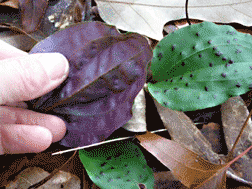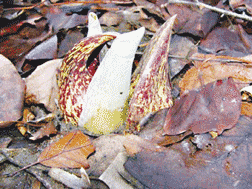|
|
|
||||||||||
|
|||||||||||
|
|||||||||||
|
Diversions and Excursions Migrant birds scratch in downed leaves, and two easily overlooked plants pick the cold
|
|||||||||||
 |
Though the now-sprouting leaves of the crane-fly orchid will wither and die come spring, they will first map for you the location where these orchids will flower and flourish in the mid-summer heat. |
Like Scorpio and Orion — two constellations that never share the night sky — thrushes take turns in Bay Country woods. Hermit thrushes arrive from northern climes in the fall as the wood thrushes finish nesting and head south. Through the winter underbrush, the hermit flits secretly and quietly. Look for a bird the shape of a small robin distinguished by snowy breast, dark brown spots and faintly russet tail.
White-throated sparrows scratch in the leaves for food along with visiting juncos and resident towhees. This species of sparrow displays two color variations: Heads may be either jaunty with black and white stripes or muted in tan and brown. This genetic diversity brings behavioral differences. The white-striped males tend to be more aggressive than their paler counterparts, the tan-striped females better mothers than the white-striped.
You’ll find all versions of these white-throated birds frequenting the ground near feeders and along the woodland edges where they occasionally burst with snippets of their spring song, Poor Sam Peabody-Peabody-Peabody. Except for the tan-striped female. She tends to keep quiet.
Their pink-billed companions, the dark-eyed juncos, feed nearby. Inconspicuous in dark gray with cream-colored bellies, these ground birds search for seeds in fallen leaves, grassy meadows and lawns. John James Audubon recognized the ubiquity of this winter migrant in 1831. “There is not an individual in the Union that does not know this little Snowbird,” he wrote. This common name has stuck, and their story is told in detail by Gary Pendleton in Bay Weekly’s Earth Journal (www.bayweekly.com/year07/issuexv50/eartjournalxv50.html).
The Eastern towhees make a dapper couple. Stocky and thrush-sized, he dresses in tuxedo black from hooded head to tail tip. White feathers glisten on his shirtfront, tail edges and wing spot; his sides are washed in burnt orange. She is similarly patterned, but her head and cloak are sienna brown. Monogamous during breeding season, they typically forage separately in winter, hopping back and forth in the leaf litter, searching for hidden seeds and berries and the first erupting insects. Listen for their chewink call, the first piece of their springtime Drink-your-tea-e-e-e-e song that sparkles in our hedgerows and woodlands.
Orchid in Purple Petticoat
Tucked in the fallen leaves where songbirds scratch and squirrels rustle, odd plants are beginning their winter cycles.
Crane-fly orchis, Tipularia discolor, is an elusive but fairly common orchid. It hides in plain sight in the summer woods, its camouflage coloration blending with the calico of the forest floor. The pale-green flowers speckled with muted lavender rise on a leafless stalk, their three-lobed lips announcing their orchid roots.
In early winter, their single three-inch egg-shaped leaves emerge. Nestled close to the ground, these green leaves sport dark purple raised spots, like tiny spiders. Their species’ name discolor, or two colors, becomes clearer when you turn them over and discover their brilliant satiny purple undersides.
Watch for the leaves decorating the northwest trails of Quiet Waters Park and in other local woodlands. Relish them now, and remember their promise. Though they will wither and die in the spring, they have mapped for you the location of their flowers, orchids that will flourish in the mid-summer heat.
 |
The emerging spathe of the winter-blooming skunk cabbage looks like a tiny caped gnome. These plants make their own heat, 30-some degrees above the surrounding air, luring pollen-carrying insects. |
Swamp Gnomes
Now head downhill to swampy streams, where another plant reverses this seasonal pattern. Winter is blooming time; the leaves must wait until spring.
Walk past the dark green Christmas ferns, their tiny leaflets waving a mittened thumbs-up. Continue downhill, down into the wetlands of the woods by streams where lacey grape ferns and smooth-edged polyploidy ferns remain resolutely green, the latter often growing profusely from the base of old trees or downed logs.
Studded throughout ice-crunchy or spongy ground, you’ll find our winter bloomer, the skunk cabbage, Symplocarpus foetidus. What you’ll discover first is not the flower, which remains hidden, but the spathe, the flower’s bulbous protective casing. This modified leaf, botanically similar to the hood of a jack-in-the-pulpit, physically takes on a wildly different form. With a sharp spike that can plow through ice or snow, the spathe of the skunk cabbage emerges like a tiny caped gnome, enrobed in colors from lime dripped with red wine to maroon speckled with crimson and white. These vivid colors blend surprisingly well with the forest floor’s leaf litter.
Tucked inside the spathe, a small, two-centimeter flower head, or spadix, resides; it is globular instead of the vertical Jack, or preacher, or jack-in-the-pulpit. Made up of many small petal-less flowers, the spadix blooms when the stamens emerge and release their wheat-colored pollen.
Miraculously, these plants produce their own warmth, much like a warm-blooded mammal. Their warmth lures emerging insects into the spathes, where they carry pollen to the style, or female part, of each hidden flower while escaping the outside chill.
“If you catch the right time, you can put your finger into the cavity formed by the spathe, and when you touch the flower head, your finger tip warms up noticeably,” says Craig Holdrege of The Nature Institute.
Biologist Roger Knutson found that skunk cabbage flowers produce warmth over a period of 12 to 14 days, remaining on average 36 degrees above the outside air temperature, whether during the day or night. The plants create heat by breaking down stored starch using great quantities of oxygen, as much oxygen as a small mammal of similar size.
The warm air spirals from the robe-like spathe, carrying a skunky odor that attracts small flies and other insects. Spiders build webs. Beetles wander by. The leaves, wrapped in a tight sheath, will fill these streamsides with luscious green by May. But for now, a microcosm of spring swirls around these gnome-like plants, taking the first swampy step out of winter.
Don’t Miss It
Take yourself on a woodland walk this winter. Listen to the chortling of the nuthatches, the fuss and bluster of the titmouse. Breathe great gulps of robust air. Watch the low sun cut through the gray trunks to shimmer on the holly. Feel the light afternoon breeze that shivers the pale coppery beech leaves still clinging to creamy branches. Watch for the orchid leaves, hunt for the skunk cabbage spathes, search for the thrushes, sparrows, towhees and juncos. They’re out there.
|
Current Issue \\ Archives \\ Subscriptions \\ Clasified Advertising \\ Display Advertising |
© COPYRIGHT 2008 by New Bay Enterprises, Inc. All rights reserved.

